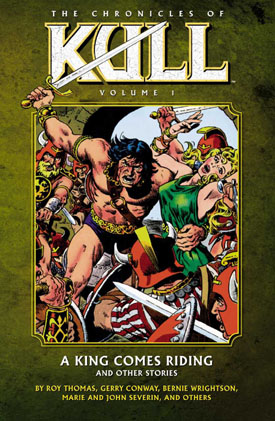 Before there was Conan, there was Kull! At least, so we were reminded on any number of covers of comics featuring stories about Robert E. Howard’s Kull, the spiritual forerunner of Conan.
Before there was Conan, there was Kull! At least, so we were reminded on any number of covers of comics featuring stories about Robert E. Howard’s Kull, the spiritual forerunner of Conan.
Kull was arguably the most important of Howard’s sword-and-sorcery heroes for several reasons. The most obvious is that he was given to introspection to a much greater degree than either Solomon Kane or Conan. He wasn’t the full-blown anti-hero that we see in Michael Moorcock’s Elric, by any means, but he was a worthy forerunner. Also, equally and perhaps even more important, in his stories of Kull Howard began constructing a universe that ultimately provided a context not only for this Atlantean exile, but for his Cimmerian successor as well, and it’s a universe that spans millennia: what we have in Howard’s Kull stories for the first time in anything that can be called heroic fantasy is history.
So, what about this version of Kull? The stories, originals based on the character, adaptations of Howard’s own stories, or those developed from his sketches and fragments, are true pulp fiction. They sometimes lack the depth of Howard’s own work, and sometimes they are a little too contrived to be completely credible. “Delcardes’ Cat,” developed from one of Howard’s drafts, involves a confrontation between Kull and a mysterious group of dwellers beneath a forbidden lake that — well, our own confrontations should be resolved this quickly and peaceably. On the whole, though, the stories, while definitely pulp fiction, are engaging and entertaining enough for any but the most critical of readers.
The art, initially created by Bernie Wrightson, Ross Andru, and Wally Wood, was soon taken over by the brother-and-sister team of Marie and John Severin, which lends a nice consistency to the later offerings. The style is strong, marked by forceful lines and definite shadows. Kull is a suitably craggy-featured King, powerfully built, and the rest of the cast is in keeping with that concept — character designs are definite and individual. The flow is firmly frame-follows-frame, and the context is very definitely illustrated story — there is a lot of text in this book, both dialogue and narration, which the images support but never supplant. The big drawback in this volume is that Dark Horse did not, for whatever reason, remaster the color — it is from the original comics, and benday dots are often quite obvious. There are also sections in which the quality of the images and even the printed text is substandard, at least in my copy. I suspect this is a fault of the originals from which this edition was taken — given the quality of the other volumes in this set (this is the third of the three books included in the boxed set, which includes The Chronicles of Solomon Kane and The Chronicles of Conan, Volume 1), I can’t see the printing being at fault.
Those issues notwithstanding, it’s an enjoyable book, and for fans of Howard or of sword-and-sorcery adventures, it’s probably a must.
(Dark Horse, 2009)
